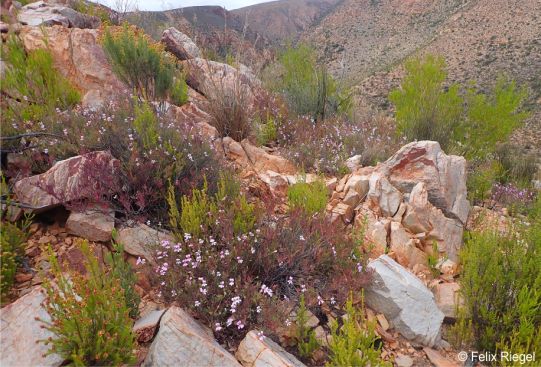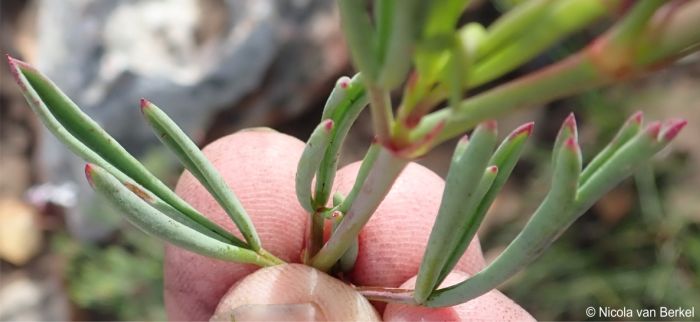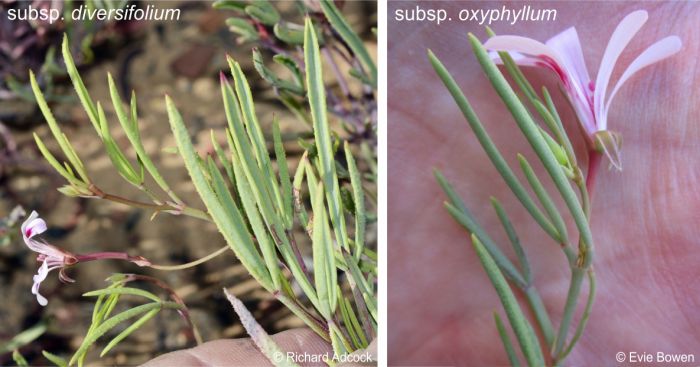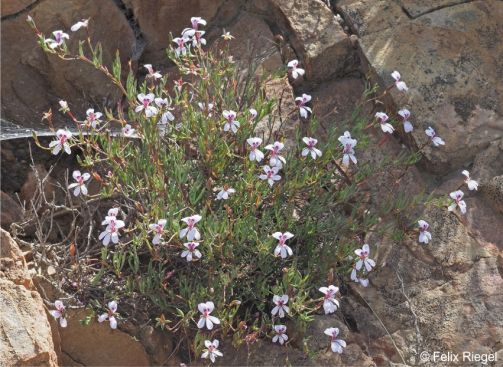Pelargonium laevigatum subsp. laevigatum
Pelargonium laevigatum (L.f.) Willd. subsp. laevigatum
Family: Geraniaceae
Common names: fine-leaf pelargonium, spearleaf storksbill (Eng.); noublaarmalva (Afr.)
Introduction
Pelargonium laevigatum subsp. laevigatum is an attractive, hardy small shrub with decorative foliage and flowers throughout the year; it is well-suited to rockeries, water-wise and dry gardens.

Description
Description
Bushy, resprouting, evergreen subshrub of 0.3–0.5 m height and diameter of 0.3–0.5 m. Growth habit varies from erect and compact to prostrate and lax. The green to grey-green stem is smooth and herbaceous. The fleshy trifoliolate leaves are smooth to sparsely hairy, often a grey-green colour and up to 50 mm long and 10 mm wide. Narrow sparsely toothed lobes of ± 5 mm wide. Flowers are solitary or occasionally in reduced pseudo-umbels of 2–5 flowers, on short axillary peduncles. Five spathulate petals present; posterior two slightly larger than anterior three.

The flowers are about 25 mm in diameter; white, pink or cream-coloured with bright purple markings on the upper petals. Calyx tube is 15–40 mm long, longer than the pedicel. Plants flower throughout the year, with a peak in spring and early summer, from September to November.

Conservation Status
Status
This species has no current threats, and its conservation status is therefore considered as Least Concern (LC) according to the Red List of South African plants.
Distribution and habitat
Distribution description
Pelargonium laevigatum subsp laevigatum occurs in the Western Cape from the vicinity of Rooiberg outside Calitzdorp eastwards to Boschberg near Somerset East in the Eastern Cape. This variable species occurs from 180 m above sea level near Humansdorp to 1 600 m in the Swartberg range. It grows in different vegetation types ranging from karoid veld, renosterveld to dry fynbos in sandy patches against slopes, scree, and also dry rock beds in full sun. The rainfall ranges from 200 to 600 mm per annum and occurs mainly during the winter months. The summers are very hot and winters are frost-free, although severe frost and snow can occur at higher altitudes.

Derivation of name and historical aspects
History
Pelargonium gets its name from the resemblance of the shape of the fruit to the beak of a stork, which is pelargos in Greek. The species name laevigatum, comes from the Latin laevigo or levigo, meaning ‘smooth’, which possibly refers to the smooth and fairly succulent leaves.
The species was first described by Swedish botanist Carl Linnaeus the Younger, under Geranium laevigatum, from a specimen brought to him by Carl Thunberg collected in the Cape between 1772 and 1775. In 1860 the section Glaucophyllum was described by Harvey and he placed the then P. laevigatum in the section. Schoncken suggested that 3 subspecies should be distinguished and this resulted in Pelargonium oxyphyllum and P. diversifolium been reclassified as subspecies of P. laevigatum and are now known as P. laevigatum subsp. oxyphyllum and P. laevigatum subsp. diversifolium respectively (Van Wyk & Van der Walt 1995). Despite more work being done on the section by Van der Walt et al (1990) it was decided to keep the species in the section.

The subspecies diversifolium and oxyphyllum can be distinguished from the subspecies laevigatum as follows:
The leaves of subsp. laevigatum are always trifoliolate (a compound leaf with 3 leaflets) and the leaflets are variously incised (have deep cuts into the margins), they are hairless to sparsely covered in stiff, coarse hairs; and the flowers are borne in pseudo-umbels of 1 to 5 flowers.
Subspecies diversifolium (hairy fine-leaf pelargonium) has both unifoliolate (leaves with one leaflet) and trifoliolate leaves, with leaflets that are not incised, and the leaves are hirsute to densely hirsute (covered in stiff, coarse hairs); it bears 1 or 2 flowers per pseudo-umbel; and it occurs in the Western Cape between Gydouw near Ceres and the Robinson Pass between Oudtshoorn and Mossel Bay, on lower mountain slopes and hills.
Subspecies oxyphyllum (Cedarberg fine-leaf pelargonium) has trifoliolate leaves with leaflets that are not incised, and the leaves are hairless; the flowers are usually borne singly, and it only occurs in the Cedarberg Mountains between Wupperthal and Citrusdal, in deep sandy sandstone soil in flat areas.

Ecology
Ecology
The subspecies laevigatum varies morphologically throughout its distribution range, but a continuous variation pattern makes it impossible to divide into different taxa. Plants from the Prince Albert region have flowers that are borne singly and leaves are linear. Plants from the Ladismith and Boschberg regions have inflorescences of up to five flowers and the leaflets may be as wide as 10 mm. Plants here also have very large petals and relatively wide pinnae.

Herbarium records indicate the section Glaucophyllum often hybridizes with species from the section Pelargonium. These records include: P. grandiflorum x P. subliginosum, P. grandiflorum x P. scabrum, P. lanceolatum x P. scabrum, P. ternatum x P. cordifolium and P fruticosum x P. scabrum (all species mentioned first are in section Glaucophyllum). P. patulum, also in section Glaucophyllum, has recorded hybrids with P. scabrum, P. cucculatum var. strigilifolium, P. cucculatum var. tabulare and P. tomentosum. Furthermore, within the section Glaucophyllum, species can also hybridize with one another. Suspected hybrids of subsp. laevigatum and P. fruticosum can be found in the Swartberg Pass where both species are common.
This species is pollinated by the diurnal, long-proboscid hovering flies, Philoliche gulola and P. rostrata of the tribes Tabanidae and Nemestrinidae. Flowers are adapted for pollination in the following ways: tubular flowers with cream to pinkish perianth, posterior petals possessing reddish purple, light nectar-guide, short stamens and a medium-sized nectar tube.
The seed is adapted to wind dispersal. Once on the ground, the seed bores its way into the soil. This is possible due to the corkscrew tail attached to the end of the seed. As the wind blows, so the corkscrew turns, much like a drill bit.
This resprouter is often found in recently disturbed areas and acts as a pioneer plant before other plants establish themselves in the habitat.
Uses
Use
Although this species has no medicinal or cultural use, horticulturally, this attractive shrub is ideal for the drier garden and will do well in a sunny position. Use it also a pot plant.

Growing Pelargonium laevigatum subsp. laevigatum
Grow
This species can be propagated from both seeds and cuttings. Take cuttings at any time of the year from a healthy vigorous plant, from softwood or herbaceous growth. Using a rooting hormone will speed up the rooting process, especially for the softwood cuttings. Place the cuttings in a container with river sand in cold frames or in a well-lit area and keep them damp. The cuttings should root in 2-4 weeks. Give the rooted cuttings a three-week weaning period and transplant them into a well-drained potting soil mix and place them in a sunny position. When they have formed a strong root-ball they can be planted into the garden.
Sow seeds in late summer to early autumn. The seeds should be sown in a light, well-drained potting mix. Sprinkle the seeds evenly in the seed tray and cover them with fine white sand or fine-milled pine bark. Water the seeds gently but thoroughly with a fine rose spray and place them in light shade with no direct sun. Seed germinates in 2-3 weeks.

Pelargoniums are some of the easiest plants to grow. This species does best in full sun, in well-drained soil and will withstand drought. It can be planted in a herbaceous border or as part of a rockery garden in combination with many other arid-loving plants.
Plant this pelargonium with species which may include: Dimorphotheca pluvialis, D. sinuata and D. cuneata, Ursinia anthemoides, Coleonema pulchellum, Agathosma gonaquensis and A. ovata, Arctotis acaulis, Pelargonium fruticosum, P. cucullatum, P. zonale, P. triste, P. ionidiflorum, P. acetosum, P. radens and P. glutinosum, Cotyledon orbiculata, Salvia aurea and S. muirii, Aloe ferox and A. aborescens, Crassula ovata and Portulucaria afra.
Water sparingly during the summer months.
References
- Adcock, R. 2016-Nov. Observation of Pelargonium laevigatum subsp. diversifolum, Waboomberg. iNaturalist. Online. https://www.inaturalist.org/observations/11230571.
- Bowen, E. 2020-Oct. Observation of Pelargonium laevigatum subsp. oxyphyllum, Cedarberg INAT https://www.inaturalist.org/observations/124764991.
- Douglas, B. & Kruger, M. 2023. Plants of the Baviaanskloof. Struik Nature. South Africa.
- Foden, W. & Potter, L. 2005. Pelargonium laevigatum (L.f.) Willd. subsp. laevigatum. National Assessment: Red List of South African Plants. https://redlist.sanbi.org/species.php?species=1976-179.
- Manning, J. & Goldblatt, P. 2012. Plants of the Greater Cape Floristic Region 1: the Core Cape Flora. Strelitzia 29. South African National Biodiversity Institute, Pretoria.
- Moriarty, A. 1982. Outeniekwa Tsitsikamma & Oostelike Klein-Karoo. Veldblomgids van Suid-Afrika 2. Botaniese Vereniging, Kaapstad.
- Riegel, F. 2025. Observations of Pelargonium laevigatum subsp. laevigatum. iNaturalist. Online. https://www.inaturalist.org/observations?taxon_id=600608&user_id=felix_riegel.
- Stearn, W. 2002. Stearn's dictionary of plant names for gardeners. Timber Press, Portland, Oregon.
- Van Berkel, N. 2018-Mar. Observation of Pelargonium laevigatum subsp. laevigatum, Langkloof. iNaturalist. Online. https://www.inaturalist.org/observations/13123075
- Van der Maesen, L.J.G., Van der Burgt, X. & Van Medenbach de Rooy, J.M. 1996. Biodiversity of African Plants. Kluwer Academic Publishers, Wageningen.
- Van der Walt, J.J. & Vorster, P.J. 1981. Pelargoniums of southern Africa, vol. 2. Juta, Cape Town, Johannesburg.
- Van der Walt, J.J.A., Albers, F & Gibby, M. 1990. Delimitation of Pelargonium sect. Glaucophyllum (Geraniaceae). Plant Systematics and Evolution 171(1/4):15-26.
- Van Wyk, C.M. (née Schonken) & Van der Walt, J.J.A. 1995. Three subspecies of Pelargonium laevigatum ( Geraniaceae ) (subsp. laevigatum; diversifolium; oxphyllum ). Bothalia 25:133-139.
- Vlok, J. & Schutte-Vlok, A.L. 2010. Plants of the Klein Karoo. Umdaus Press, Hatfield.
Credits
Trevor Adams
Kirstenbosch National Botanical Garden
June 2009
Updated & expanded by Roger Oliver
Kirstenbosch National Botanical Garden
June 2025
Acknowledgements: images by Richard Adcock, Evie Bowen, Felix Riegel and Nicola van Berkel.
Plant Attributes:
Plant Type: Shrub
SA Distribution: Eastern Cape, Western Cape
Soil type: Sandy, Clay, Loam
Flowering season: Spring, Early Summer, Sporadic/All year
PH: Acid
Flower colour: Purple, White, Pink, Cream
Aspect: Full Sun
Gardening skill: Easy
Special Features:
Horticultural zones









Rate this article
Article well written and informative
Rate this plant
Is this an interesting plant?
Login to add your Comment
Back to topNot registered yet? Click here to register.